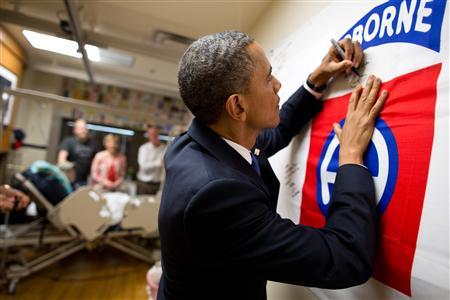(Reuters) – On a blistering June afternoon, President Barack Obama slipped into Walter Reed National Military Medical Center to spend time with soldiers wounded in Iraq and Afghanistan. It was the most recent of his nearly weekly gestures intended to reinforce his commitment to America’s troops and veterans.

Across town that day, hundreds of unemployed veterans shuffled through a wing of the Washington Nationals baseball stadium, many hoping that at this job fair they would catch a break. Among them was Nick Tivas, a 23-year-old Iraq war veteran with a buzz cut and a grievance against the Department of Veterans Affairs.
A collection agency has come after the former infantryman, he said, and he’s looking for work because he thinks he’ll have to drop out of community college after a dispute with the VA over education benefits. He also complained that it had been nearly a year since he filed a disability claim for a knee injury, with no word from the VA.
“I have a feeling I’ll have gray hair and grandchildren and still be dealing with some kind of problem from the VA,” he said.
The two scenes unfolding in the capital that day played out on opposite sides of a chasm: on one side, Obama’s pledges in support of America’s returning warriors; on the other, the limits of what he has been able to do to mend a tattered safety net for the nation’s 23 million veterans.
“We cannot expect our young men and women to serve in our armed forces if we are not making sure that when they come home, they are getting the treatment they deserve,” Obama said on the campaign trail in 2008.
Four years later the U.S. president can take credit for one of the most comprehensive efforts since World War II to overhaul the VA. His 2013 budget request for the VA is more than $40 billion, or 41 percent, bigger than the one he inherited when he took office, helping to cover construction of hospitals and clinics, staff increases, and expanded disability benefits. That has come despite the warning from some in the outgoing George W. Bush administration that the VA apparatus “is broken, just play defense,” according to a member of Obama’s transition team.
Yet, based on interviews with veterans, their advocates, and VA and other administration officials, as well as a review of available data, life for many veterans has grown more challenging under Obama’s watch.
Veterans returning home today join lines for disability payments much longer than those Obama called intolerable in 2008. Their chances of finding jobs in a bleak economy are worse than those of most other Americans. Veterans’ complaints of employment discrimination by the federal government have actually risen.
Veterans remain more likely to be homeless than the general population. The VA estimates more than 67,000 sleep in shelters and on the streets or are otherwise considered homeless, a figure that is only slightly better than in 2009.
And improved data collection reveals just how bad the problem of suicide is among veterans. According to new data Reuters obtained from the VA, a veteran within the VA healthcare system tries to commit suicide about once every half-hour, on average.
The reasons for this gap between intentions and results are manifold: a troubled economy, a divided Congress, an inefficient bureaucracy. These are compounded by the strain of four more years of conflict on American troops, whose needs will keep growing long after the wars are over.
Eric Shinseki, the man Obama chose to turn the VA into a more veteran-friendly operation, recognizes the urgency of the situation, but also takes a long view. “What (Obama) asked me to do was make those fundamental, comprehensive changes today that would serve the VA for a long time,” the 69-year-old secretary of veterans affairs and former U.S. Army chief of staff said in an interview with Reuters. “Not two-year changes or five-year changes, but put in place the processes, the systems, the disciplines, the behaviors that would change this in transformational ways for a very long time.”
The problems faced by veterans such as Andy Orellana, a 26-year-old homeless Iraq war veteran in Chicago, are immediate. Earlier this year the shelter where he sought refuge initially placed him on an “overflow” floor with a general population that included ex-convicts.
“One of the guys … turned to me and was like, ‘What are you in for?’ ” Orellana said. “I was like, ‘I’m a vet.’ ”
“We’re going to … cut those backlogs, slash those wait times, deliver your benefits sooner.”
— Obama, to a Veterans of Foreign Wars convention, August 17, 2009
In the second year of Obama’s presidency, a curious thing happened at the Poff Federal Building in Roanoke, Virginia. So many folders stuffed with claims had piled up — thousands of them, stacked on top of filing cabinets — that they were declared a threat to the building’s structural integrity.
The files were moved, but the national pileup of disability compensation claims has continued. The backlog of claims languishing in the VA system for more than 125 days increased fourfold from October 2009 to mid-July 2012, according to VA data, to 572,856 claims.
Although the VA added staff, ramped up training and processed more and more pension and compensation claims — topping a million in both 2010 and 2011 — the average time spent processing each claim grew from 2009 to 2011. (VA data generally refer to the U.S. fiscal year, ending September 30.)
Elizabeth Lyman suffered from post-traumatic stress disorder after allegedly being raped in 2008, a Marine at the time and 11 weeks pregnant. It took her two years to navigate the VA system and start receiving disability payments after she filed her claim.
Lyman, who left the Marines in 2010, was part of a lawsuit with 27 others seeking damages for alleged military inaction over rape. A U.S. district court dismissed that case in December, ruling that it lacked the authority to hold Pentagon officials liable. The plaintiffs are appealing.
Meanwhile, Lyman, 29, worries it may be too late to piece her life back together. She developed a drinking problem, and she has nightmares, flashbacks and crying fits. Her parents briefly took over care of her 3-year-old son this year.
“They say (in the Marines), look out for the Marines to the left and the right of you,” said the Corpus Christi, Texas, resident. “They didn’t do that with me … They failed me in every aspect.”
The VA expressed regret over the delay in processing Lyman’s claim, blaming “procedures not being followed properly and the volume of claims at the Houston Regional Office.” Lyman said she is now receiving a monthly disability payment of $2,873. The VA also agreed to a retroactive payment of $33,867.
In the case of Tivas, the Iraq war veteran, a query by Reuters led the VA to examine his nearly year-old compensation claim for a knee injury, and on July 19, it authorized a monthly compensation award.
But the dispute over his education benefits continues. Tivas says the VA was late handling his paperwork, creating a cascade of troubles and leading him to drop classes. The VA insists he was overpaid, even if late, because he dropped classes. He may be a candidate for a waiver, however, to free him from debt, it said.
As it turns out, the administration’s efforts to help veterans are part of the reason for the long waits.
A 2010 decision to acknowledge Vietnam veterans’ right to claim compensation for more illnesses linked to the defoliant Agent Orange led to a deluge of claims from older veterans. Likewise, staff had to be diverted to handle a crush of claims when Iraq and Afghan veterans filed to take advantage of education benefits under the 2008 GI bill, which were later expanded under Obama. The president also made it easier to get compensation for post-traumatic stress disorder, ending the requirement that combat troops prove their illness was service-related.
Mostly, though, it is the long and continuing wars overseas that have overwhelmed the claims process. Returning Iraq and Afghan veterans have survived combat injuries at a far higher rate than veterans of previous wars, with record numbers of disabilities.
Retired Air Force Brigadier General Allison Hickey, who is leading the VA’s effort to overhaul the claims process, said Iraq and Afghanistan veterans have an average of nine to 11 “contentions” — or medical issues — per claim, more than twice the number filed by veterans from the Vietnam era.
“Yes, some of the numbers don’t look so great right now. Yes, people are waiting some time. But the solution is where we’re going,” Hickey said.
That solution entails replacing the VA’s paper claims tracking system with an electronic system that has been years in development, at a cost of hundreds of millions of dollars. Officials say that if the new system, now in use at four of the VA’s 56 regional offices, is fully rolled out by the end of 2013, as planned, the department will meet Shinseki’s target of eliminating the claims backlog by 2015.
Even backers of the paperless system are skeptical that the VA can achieve its goal. Others with knowledge of the system warn that speeding up claims doesn’t ensure accuracy or fairness and that errors from years past will haunt the VA for decades.
“It’s about 10, 15 years too late for whatever they’re going to introduce. And I don’t have any optimism that it’s going to work,” said Frank Nebeker, the first chief judge of the U.S. Court of Appeals for Veterans Claims. He retired from the court in 2000, but periodically returns to serve as a judge.
“Allow All Veterans Back into the VA: When troops serve, they are not divided by income classes or priority groups. Yet, today the VA is picking and choosing which veterans to serve … As president, one of Barack Obama’s first acts will be signing an executive order reversing this ban.”
— Obama’s pledge sheet on veterans policy for the 2008 campaign, “Fulfilling a Sacred Trust with Our Veterans”
Worried about ensuring healthcare for wartime wounded and lower-income veterans, the Bush administration in 2003 banned enrollment of certain veterans who had no injuries related to their military service and who had incomes above a set threshold.
The Obama administration raised the income threshold, making an additional 650,000 veterans eligible for healthcare, according to VA data. But he has not fulfilled his promise to let all veterans back into the system, and millions of veterans remain ineligible.
An administration official blamed the economic crisis and ballooning deficits. “Fiscal reality set in,” said a veterans’ advocate who provided information to the 2008 campaign.
For veterans who have access to the system, Obama’s goals for timely mental-health treatment are not being met.
An investigation by the VA’s inspector-general in April found that more than half of veterans who needed comprehensive mental-health evaluations had not received them within two weeks of initial contact, the VA’s target. That contradicted the VA’s annual report to Congress last year, which said 95 percent of first-time patients received a full mental-health evaluation within 14 days.
“VA is failing to meet its own mandates for timeliness and instead is finding ways to make the data look like they are complying,” said Washington Senator Patty Murray, a Democrat and chair of the Senate Veterans’ Affairs Committee.
Critics say part of the problem is that staff increases have only kept pace with patient loads. An analysis of VA data shows that the ratio of VA mental-health patients per full-time mental-health worker, at 65 to 1, was roughly unchanged in 2011 from 2006. Data obtained by Reuters shows there were 1,500 VA mental-health job vacancies nationwide at the end of December. In April the VA announced plans to hire 1,600 mental-health clinicians.
Nicholas Tolentino, an Iraq and Afghanistan war veteran, quit his job as a mental-health administrative officer at the Manchester, New Hampshire, VA Medical Center in December over what he said was its failure to provide needed care to veterans.
“The goal was to see as many veterans as possible, but not necessarily to provide them the treatment they needed,” Tolentino told the Senate Veterans Affairs Committee in April. He said the facility manager focused on a veteran’s immediate problem, treating it quickly, “usually, with medications … And don’t ask further questions about needs, because, and I quote, ‘We don’t wanna know or we’ll have to treat it.’ ”
“Fight Veterans Employment Discrimination: … As president, Barack Obama will invest additional resources into enforcement and investigation in order to crack down on employers who are not following the letter and spirit of the law.”
— “Fulfilling a Sacred Trust with Our Veterans”
As a candidate, Obama called for stricter enforcement of a 1994 law – the Uniformed Services Employment and Reemployment Rights Act, or USERRA – that prohibits employers from discriminating against current and former service members, and stressed the need for special help for guardsmen and reservists.
Since 2001, the number of complaints against all employers under USERRA has risen 73 percent, to 1,548 last year. The employer that accounted for the single biggest number of complaints was the federal government, with 286, or 18 percent of the total. That is the highest number since 2006.
“If the federal government, through this law, is imposing this obligation on gas station owners and bar operators and taxi cab companies, (it) ought to be doing at least as much and probably a lot more for its own employees,” said Sam Wright, a former Labor Department employee who helped draft USERRA.
Much of the rise in complaints, experts say, was expected with the wave of reserve troops returning home, and attempting to return to their old jobs, after long deployments. An administration official also cited a statistical reason: Veterans make up more than a quarter of the federal workforce, the highest share in 15 years.
Despite a roughly 10 percent rise in the budget of the Labor Department office that handles the complaints, critics say the process remains disjointed and investigations are weak. “Some investigators don’t have their heart in it,” said Bob Kuenzli, a USERRA investigator who retired in September.
The administration has made high-profile efforts to help returning troops find jobs. It has championed tax credits meant to encourage companies to hire veterans. First Lady Michelle Obama’s “Joining Forces” initiative says it has helped more than 90,000 veterans and military spouses find jobs and expects to exceed its 100,000 target by 2013. Obama is pushing Congress to create a Veterans Jobs Corps.
On July 19 the president issued a memorandum calling on federal agencies to protect veteran workers’ rights, saying: “No discrimination or unfair treatment based on one’s service will be tolerated.”
All of which can’t mask the grim job market for Iraq- and Afghanistan-era veterans in an anemic economy. Unemployment among this group rose from 7.3 percent in 2008 to 12.1 percent in 2011, when the national average was 8.9 percent. For 18- to 24-year-old veterans, the rate was 30 percent last year, nearly double the 16.1 percent rate for non-veterans in that age group.
At the Washington job fair last month, a pep talk kicking off the event was meant to lift the spirits of unemployed veterans as they passed booths of recruiters from Wal-Mart, McDonald’s and other major companies. Andrew Colon winced when a singer told the crowd, “You guys are very lucky to be here today.”
“I don’t think we’re lucky to be here. We’re unemployed and we’re trying to find a job,” said Colon, clutching a bundle of resumes.
Colon, 25, served in Iraq and Afghanistan, where in 2009 he helped sort through claims by Afghans seeking compensation for damage by U.S. forces like shot cows and destroyed homes. Now, after earning a degree in May, he’s trying to find a job in public relations.
He had no luck at the fair, but an interview he had arranged separately with the Armed Forces Services Corp., a U.S. government contractor, yielded an offer for a job as a new media specialist, contingent on government approval. He’s optimistic.
Tivas, meanwhile, didn’t drop off any resumes at the fair, his first; he said he was more interested in seeing what it entailed. He was confident about finding work. “I’m the type of person who gets jobs,” he said.
“I am going to put in a policy of zero tolerance. We will not have any veteran who is homeless or on the streets when I’m president of the United States.”
–Obama in Bayamon, Puerto Rico, May 24, 2008
Andy Orellana will never forget his first night at A Safe Haven, the Chicago shelter where the homeless veteran eventually ended up after an honorable discharge in 2008. Just hours after he arrived and handed over his clothes to be washed in case he had bedbugs, one of the residents was shot while hanging out across the street.
Orellana said he was placed that day onto the overflow floor with some former convicts before being moved to a vet-only floor. “Everyone pretty much keeps to themselves,” he said.
The shelter said the shooting was a singular occurrence and that while it doesn’t accept violent or sex offenders, many of the homeless have convictions related to drugs, alcohol or theft.
In a room with chipped paint on the walls and his roommate’s clothes piled on the bed next to him, Orellana praised the VA treatment he has received for PTSD and depression — conditions resulting, he said, at least in part from having seen a fellow soldier burn to death in Iraq. Even so, he said, the VA had so far denied him disability benefits.
“I guess they didn’t believe me,” he said with a shrug.
Reuters has been unable to contact Orellana since shortly after his May interview. A person familiar with his situation said he recently received a U.S. government housing voucher and was searching for an apartment. The VA declined to comment, citing the need to obtain permission from individuals before discussing their cases.
When Obama ran for president, he stated his intention to eliminate veteran homelessness. Once the administration settled in, Shinseki set an ambitious target date of 2015.
But a VA document seen by Reuters — which a spokesman described as “pre-decisional” — shows that the target is subject to possible review.
“Things that would make us look at our time line would be things like the military drawdown and how veterans are impacted,” said Lisa Pape, the national director for homeless programs at the Veterans Health Administration, in late March. Unemployment rates are a factor, too, “and as you know, they’ve not been decreasing.”
The administration says the number of homeless veterans fell 10.7 percent from 2009 to 2011 – there was a tiny rise in 2010 — to 67,495. That figure is the result of the latest in a series of methodologies used for the count. Many veterans’ advocates and lawmakers say the count is only a rough estimate.
Representative Bob Filner, the top Democrat on the House Veterans’ Affairs Committee, dismissed the data and the 2015 goal. “So you’ve got 88 percent more to go, so how are you going to do it?” Filner said. “Besides, I don’t believe it.” He said he thinks the number is actually rising in some parts of the country.
Filner is running for mayor of San Diego, where Phil Landis, president of Veterans Village of San Diego, said he’s seeing anecdotal evidence that today’s “young veterans fall into homelessness sooner than prior generations.”
Shinseki is creating a national registry to track not only those who are homeless but also those at risk of becoming homeless — an unprecedented effort that has so far amassed more than 400,000 names. Shinseki hopes to be able to swoop in and help veterans, such as those caught up in the foreclosure process, before they end up on the streets.
“I have never been able to solve a problem I couldn’t see,” he said, adding that the VA was on track to meet his 2015 goal.
The Obama administration has also expanded the use of a housing-vouchers program — fulfilling one of Obama’s campaign promises by allowing more veterans to stay off the streets by renting private housing. The VA estimates that about 40,000 veterans benefit from the vouchers and expects that number to rise to 48,000 by the end of the year and 60,000 in 2013.
* * *
Even if the payoff is still a ways off, the politics of tackling the VA’s problems make sense: The military vote could prove decisive in November’s presidential election. Many veterans are concentrated in key swing states.
And Obama’s choice of Shinseki to run the VA has been popular with many veterans. A Vietnam veteran who lost part of a foot in the war, the former Army chief says he takes the issues personally.
“You don’t get too many do-overs in life, and for me, this is a do-over,” he said on an April visit to a VA clinic in rural Pennsylvania. “I get a chance to take care of the kids I went to Vietnam with 40 years ago. I get to take care of the youngsters I sent to war as a chief.”
(Additional reporting by Alexandra Alper, Matt Spetalnick, Lily Kuo and Eric Johnson; editing by Marilyn Thompson, Warren Strobel, John Blanton and Douglas Royalty)





